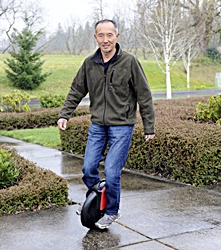 Monowheels belong to the growing family of self-balancing vehicles. The world saw the prototype of a monowheel at Bike Expo in 2010 in Nevada, where the legendary Chinese inventor Shane Chen demonstrated his latest invention – a one-wheeled self-balancing vehicle, which was called Solowheel. The idea proved to be viable, and now the one-wheeled vehicles that are based on electric gyro sensors have quickly started to spread around the world. Besides Solowheel many other brands have emerged, such as Monowheel, Firsthwheel, Airwheel, IPS, to name just a few.
Monowheels belong to the growing family of self-balancing vehicles. The world saw the prototype of a monowheel at Bike Expo in 2010 in Nevada, where the legendary Chinese inventor Shane Chen demonstrated his latest invention – a one-wheeled self-balancing vehicle, which was called Solowheel. The idea proved to be viable, and now the one-wheeled vehicles that are based on electric gyro sensors have quickly started to spread around the world. Besides Solowheel many other brands have emerged, such as Monowheel, Firsthwheel, Airwheel, IPS, to name just a few.
The functioning principle is the same for all monowheels. The wheel consists of an electric motor, which triggers the wheel, a battery and a gyro sensor, which reacts if the centre of gravity of the wheel tilts forward or backward. The sensor manages the electric motor in such a way that the wheel is always trying to get back to the balance point. Therefore, when you tilt yourself forward or backward, the wheels always tries to move back under the rider. The rider only needs to keep the balance on the sides, which at first glance seems like a serious acrobatic stunt but is actually surprisingly simple.
The differences between the various brands and models essentially just mean the differences in the colour and shape of the casing, the battery capacity and engine power. The last trend seems to be adding various "bells and whistles", i.e., light shows and multimedia capabilities to the wheel. The wheels have built-in speakers, which can be connected to a smartphone via Bluetooth.
Monowheels have a good potential to become the future of a personal transportation device. It allows you to move up to three times faster than walking, is easily manoeuvrable and very accurately controlled. In addition, it is compact. All this makes monowheels appropriate means of transport to go to work or school. The wheel moves fast but it does not make you perspire. If you also use public transport then unlike the bicycle, it is not a problem to take a monowheel to a public transport even during peak hours. After arrival, the wheel can be taken along like a small suitcase and placed beside a desk. There is no parking problem. The wheel can be used on both pathways and on city sidewalks.
Monowheels do not make any noise or emit exhaust fumes, thus saving the urban environment from pollution, which is a particularly serious problem in metropolises with high population density. Therefore, it is not surprising that the wheels have begun to spread particularly fast in Asia, as well as in the great cities of the western world. In some countries, there are even movements promoting monowheels. Youth gangs on noisy mopeds are replaced by gangs hanging on monowheels. It is also becoming more and more popular to perform tricks on monowheels.



